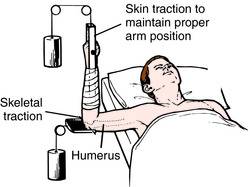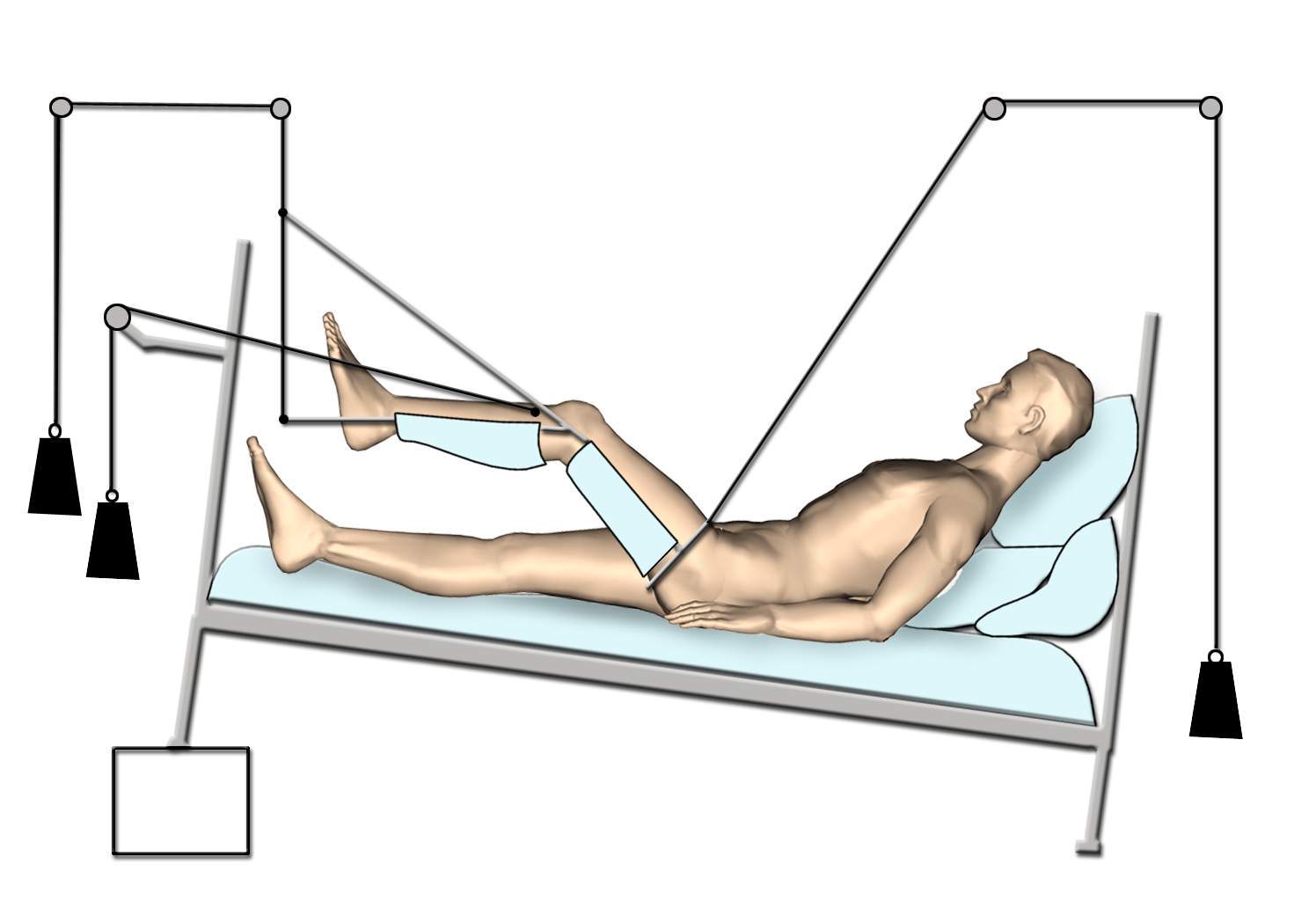
 |
Upload | Sign in/out |
|---|
In orthopaedic medicine, traction refers to the set of mechanisms for straightening broken bones or relieving pressure on the spine and skeletal system. There are two types of traction: skin traction and skeletal traction.
Traction procedures are largely replaced now by modern techniques, but certain approaches are still used today:
• Milwaukee brace

• Bryant's traction

• Buck's traction, involving skin traction. It is widely used for femoral fractures, low back pain, acetabular fractures and hip fractures. Skin traction rarely causes fracture reduction, but reduces pain and maintains the length of the bone.

• Dunlop's traction – humeral fractures in children

• Russell's traction

Traction is usually applied to the arms and legs, the neck, the backbone, or the pelvis. It is used to treat fractures, dislocations, and long-duration muscle spasms, and to prevent or correct deformities.
Traction can either be short-term, as at an accident scene, or long-term, when it is used in a hospital setting.
Traction serves several purposes:
• it aligns the ends of a fracture by pulling the limb into a straight position
• it ends muscle spasm
• it relieves pain
• it takes the pressure off the bone ends by relaxing the muscle.
There are two main types of traction: skin traction and skeletal traction. Within these types, many specialized forms of traction have been developed to address problems in particular parts of the body. The application of traction is an exacting technique that requires training and experience, since incorrectly applied traction can cause harm. Skin traction
Skin traction uses five-to seven-pound weights attached to the skin to indirectly apply the necessary pulling force on the bone.
If traction is temporary, or if only a light or discontinuous force is needed, then skin traction is the preferred treatment. Because the procedure is not invasive, it is usually performed in a hospital bed.
Weights are attached either through adhesive or nonadhesive tape, or with straps, boots, or cuffs.
Care must be taken to keep the straps or tape loose enough to prevent swelling and allow good circulation to the part of the limb beyond the spot where the traction is applied. The amount of weight that can be applied through skin traction is limited because excessive weight will irritate the skin and cause it to slough off.
Specialized forms of skin traction have been developed to address specific problems. Dunlop's traction is used on children with certain fractures of the upper arm, when the arm must be kept in a flexed position to prevent problems with the circulation and nerves around the elbow.
Pelvic traction is applied to the lower spine, with a belt around the waist. Buck's skin traction is used to treat knee injuries other than fractures. The purpose of this traction is to stabilize the knee and reduce muscle spasm. Skeletal traction
Skeletal traction is performed when more pulling force is needed than can be withstood by skin traction; or when the part of the body needing traction is positioned so that skin traction is impossible. Skeletal traction uses weights of 25-40 pounds.
Skeletal traction requires the placement of tongs, pins, or screws into the bone so that the weight is applied directly to the bone.
This is an invasive procedure that is done in an operating room under general, regional, or local anaesthesia.
Correct placement of the pins is essential to the success of the traction. The pin can be kept in place several months, and must be kept clean to prevent infection.
Once the hardware is in place, pulleys and weights are attached to wires to provide the proper pull and alignment on the affected part.
Specialized forms of skeletal traction include cervical traction used for fractures of the neck vertebrae; overhead arm traction used for certain types of upper arm fractures; and tibia pin traction used for some fractures of the femur, hip, or pelvis.